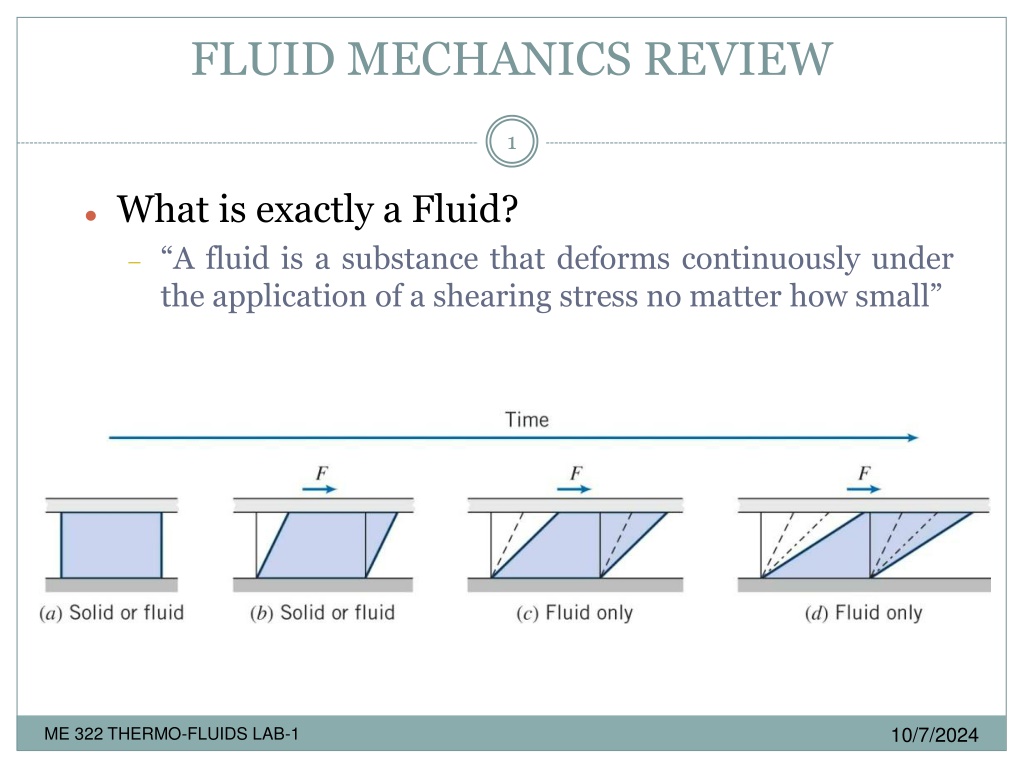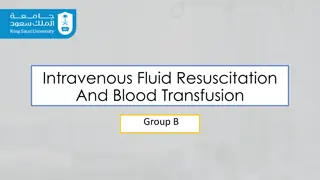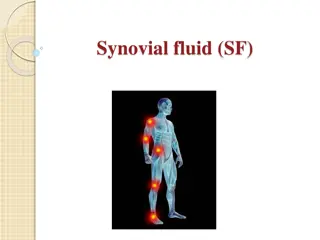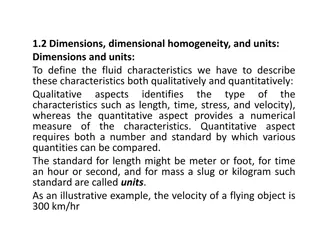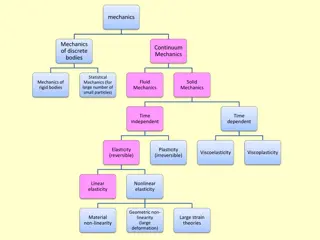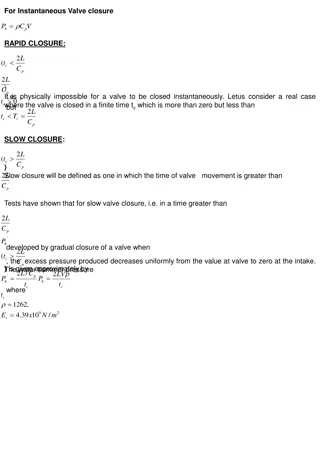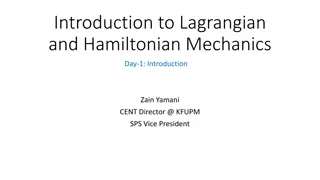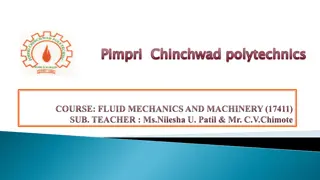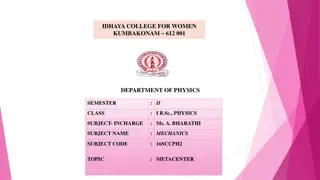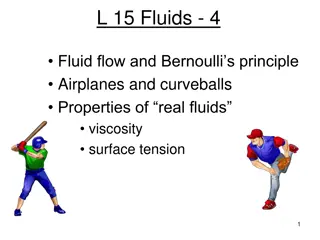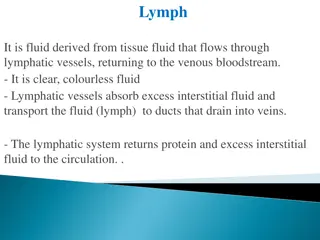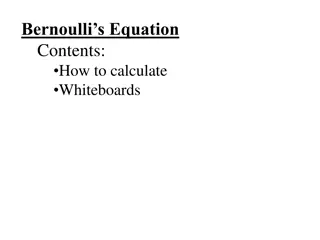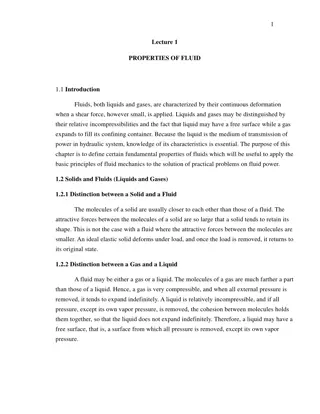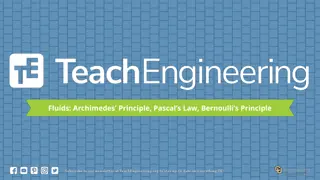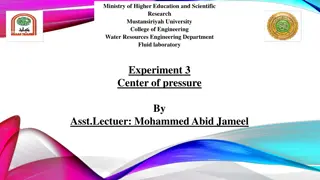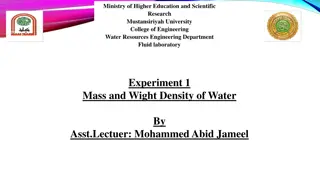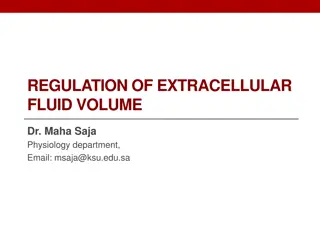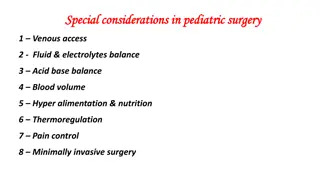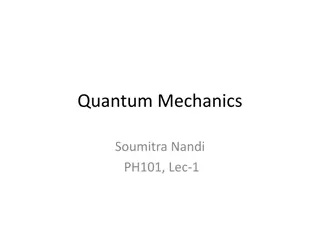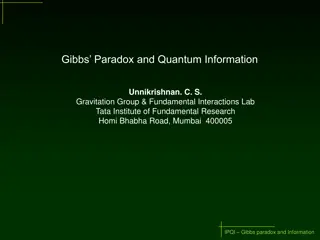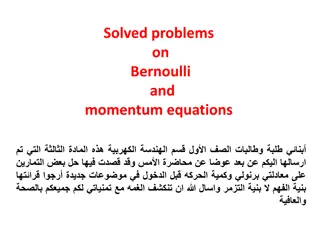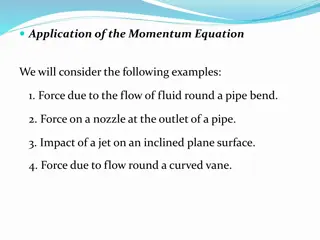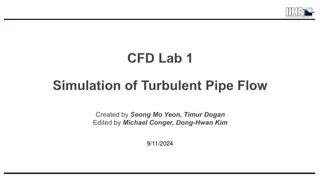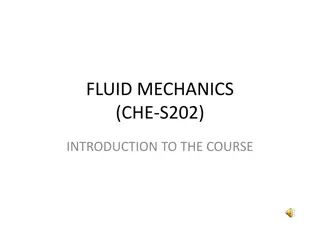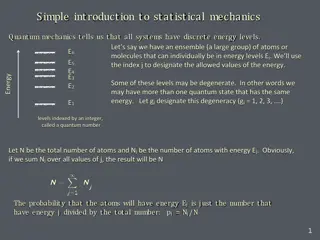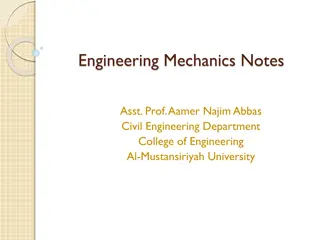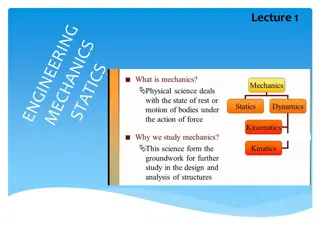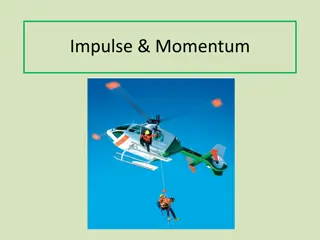Understanding Fluid Mechanics Fundamentals
Fluid mechanics is the study of how fluids behave and interact under various conditions. This review covers essential concepts such as fluid classification, basic equations, control volumes, the importance of the no-slip condition, and pressures in fluid flow. It provides insights into the nature of fluids, their properties, and key principles governing their behavior in different contexts.
Download Presentation

Please find below an Image/Link to download the presentation.
The content on the website is provided AS IS for your information and personal use only. It may not be sold, licensed, or shared on other websites without obtaining consent from the author. Download presentation by click this link. If you encounter any issues during the download, it is possible that the publisher has removed the file from their server.
E N D
Presentation Transcript
FLUID MECHANICS REVIEW 1 What is exactly a Fluid? A fluid is a substance that deforms continuously under the application of a shearing stress no matter how small 10/7/2024 ME 322 THERMO-FLUIDS LAB-1
FLUID MECHANICS REVIEW 2 Classification of Fluid Motion 10/7/2024 ME 322 THERMO-FLUIDS LAB-1
FLUID MECHANICS REVIEW 3 Basic Equations Conservation of mass Conservation of momentum (Newton's second law) Conservation of moment of momentum (angular momentum) First Law of Thermodynamics Second Law of Thermodynamics In addition we need Equation of state (in case of gases) Physical properties of fluid (density, viscosity, heat capacity) Boundary conditions (non-slip condition: any fluid acquires the velocity of the surface it is in contact with) 10/7/2024 ME 322 THERMO-FLUIDS LAB-1
FLUID MECHANICS REVIEW 4 What is a Control Volume An arbitrary volume in space Fluid pass through it's boundaries Boundaries can be fixed or moving The surface enclosing the control volume is called a Control Surface Control surface can be real or imaginary 10/7/2024 ME 322 THERMO-FLUIDS LAB-1
FLUID MECHANICS REVIEW 5 No-Slip Condition Any fluid flowing over a solid surface, the layer of fluid in contact with the surface acquire the surface s velocity. Newtonian Fluid Fluids in which the shear stress is directly proportional to the rate of deformation are called Newtonian Fluids. Other fluids where the stress is a more complex function are called Non-Newtonian Fluids. du yx Viscosity du = yx dy dy is called viscosity or dynamic viscosity. It has dimensions of [M/Lt] Units for are, 1 poise 1 g/(cm.s) Kg/(m.s) Another related quantity is the kinematic viscosity , defined as , 2 / = M s 10/7/2024 ME 322 THERMO-FLUIDS LAB-1
FLUID MECHANICS REVIEW 6 Static, Dynamic and Stagnation Pressures Static pressure, ?, is the pressure that is felt by the fluid as it moves in the flow field Stagnation pressure, ?0, is the pressure the fluid experiences as it is brought to rest with no losses Dynamic pressure is 1 For incompressible flow ?0= ? +1 2 ??2 If the static and stagnation pressures are known we can calculate the flow velocity as 2??2 2 ?0 ? ? ? = 10/7/2024 ME 322 THERMO-FLUIDS LAB-1
FLUID MECHANICS REVIEW 7 Boundary Layer on a flat plate 10/7/2024 ME 322 THERMO-FLUIDS LAB-1
FLUID MECHANICS REVIEW 8 Fully Developed Flow When a uniform flow enters a pipe or a duct, due to the no slip condition at the walls along the entire length of the pipe or duct, an entrance region is formed where the velocity profile develops. A boundary layer, where viscous effects are dominant develops at the walls. The velocity of the is retarded due to the shear stress exerted by the walls. The effects of the wall reach further away from the wall as the flow moves along the duct. 10/7/2024 ME 322 THERMO-FLUIDS LAB-1
FLUID MECHANICS REVIEW 9 Entrance Region Where ? is the average speed in the pipe. Since laminar flow is expected for Re<2300, then ? 0.06? ?? ? ? = 0.06 ?? ? 0.06 2300 ? ? 138? For turbulent flows, the entrance length estimated from experiments is about 25 40 pipe diameter. This is due to the fact that there is more mixing in turbulent flows. 10/7/2024 ME 322 THERMO-FLUIDS LAB-1
FLUID MECHANICS REVIEW 10 Fully developed laminar flow in a circular pipe The velocity is given by ? = ?2 4? Shear Stress ???=? 2 ?? ?? ? ? 1 ?? ?? 2 Volume flow rate ? ?2???? = ??4 ?? ?? ? ? ? = ? = ????? = 8? ? ? 0 10/7/2024 ME 322 THERMO-FLUIDS LAB-1
FLUID MECHANICS REVIEW 11 Fully developed laminar in a circular pipe Volume flow rate as a function of pressure drop ? = ??4 =??4 ? 8?? =??4 ? 128?? ? ? 8? Average Velocity ??2= ?2 ? =? ? ?? ?? ?= 8? Position of Maximum Velocity ?? ??= 1 ?? ?? ? = 0 2? ??= 0 ? = ????= ? = ?2 At ? = 0 ,?? Hence we can write the velocity in non-dimensional form as, ? ?= 1 ?? ?? = 2 ? 4? 2 ? ? 10/7/2024 ME 322 THERMO-FLUIDS LAB-1
FLUID MECHANICS REVIEW 12 Turbulent velocity profile in fully developed pipe flow The velocity profile can be approximated as, 1 ?= 1 ? 1 ? ? ?= ? ? ? The exponent n varies with Reynolds number. This formula gives an infinite value of velocity gradient which is clearly incorrect however, it is still useful to calculate average velocities. The exponent n can be written as a function of Reynolds number according to Hinze, as ? = 1.7 + 1.8log??? A value of n=7 is typical. This is referred to one-seventh profile 1 7= 1 ? 1 7 ? ?= ? ? ? 10/7/2024 ME 322 THERMO-FLUIDS LAB-1
FLUID MECHANICS REVIEW 13 Turbulent velocity profile in fully developed pipe flow 10/7/2024 ME 322 THERMO-FLUIDS LAB-1
FLUID MECHANICS REVIEW 14 Energy Considerations in Pipe Flow Assumptions: ??= 0, ??? ??= 0 ?? ???= 0 3. Steady Flow Incompressible flow Internal energy and pressure are uniform across sections 1 and 2 ??? ??=? ?? Where, ? = ? +?2 1. 2. 4. 5. ? + ?? ?? ? ? ? ?? ?? ??? ???? + ?? ?? 2+ ??and ? is the internal energy. 10/7/2024 ME 322 THERMO-FLUIDS LAB-1
FLUID MECHANICS REVIEW 15 Energy Considerations in Pipe Flow ?1 ?+?1 ?12 2 This equation enables us to calculate the losses occurring in a section of the pipe. If the flow is frictionless, then there are no losses ??= 0 and ? = 1. In this case we get Bernoulli s equation. Each term in the equation has dimensions of ?2 divide by ?, it would have dimensions of length ?. ?1 ??+?1 ?12 2? ?2 ?+?2 ?22 + ??1 + ??2 = ?? 2 ?2 , so if we ?2 ??+?2 ?22 = ?? + ?1 + ?2 = ??? 2? ? 10/7/2024 ME 322 THERMO-FLUIDS LAB-1
